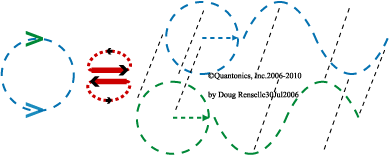|
98 |
"Now, if
space
is to be [classically] defined
[see define] as the homogeneous,
it seems that
| Time, in so in so far as it is a homogeneous medium, and not
concrete duration, is reducible to space. |
inversely every homogeneous
and unbounded medium will be space.
For, homogeneity here consisting in the absence of every quality,
it is hard to see how two forms of the
homogeneous could be distinguished from one another.
Nevertheless it is generally agreed |
to regard time as
an unbounded medium, different from space
but homogeneous like the
latter: the homogeneous is thus supposed to take two forms,
according as its contents co-exist or follow one another. It
is true that, when we make time
a homogeneous medium in which
conscious states unfold themselves, we take it to
be given all at once, which amounts to saying that we abstract
it from duration. This simple consideration
ought to warn us that we are thus unwittingly falling back upon
space, and really giving up time. [And thus, we query,
"Is all homogeneity space?"]
Moreover, we can understand that material objects, being exterior
to one another and to ourselves, derive both exteriorities from
the homogeneity of a medium which inserts intervals between them
and sets off their outlines: but states
of consciousness, even when successive, permeate one another,
and in the simplest of them the whole
soul can be reflected. We may therefore surmise
that time, conceived under the form
of a homogeneous medium, is some
spurious concept, due to the trespassing of the idea of space upon the field of pure consciousness." |
(Our link, brackets, bold, color, and violet bold italic problematics.)
Bergson restarts his footnote counts on each page. So to refer
a footnote, one must state page number and footnote number.
Our bold and color highlights follow a code:
- black-bold - important to read if you are just scanning
our review
- orange-bold - text ref'd
by index pages
- green-bold - we see Bergson
suggesting axiomatic memes
- violet-bold - an apparent
classical problematic
- blue-bold - we disagree
with this text segment while disregarding context of Bergson's
overall text
- gray-bold - quotable
text
- red-bold - our direct
commentary
When newborns unfold themselves,
what happens to their local times? Does a newborn predicably
possess a know-ledge about classical homogeneous unilogical time?
If it does, explain how. If it appears not to, why do you think
that, yet still you accept (assuming you are a classicist and
thingk classically)
that your conception of time is homogeneous. On a related
question: when does a next generation commence? Is it
a homogeneous percept or a heterogeneous percept? Are there many
generations, or just one classical generation every 20 years
which fixes that generation for everyone who was synchronously
born into it? Is time really a classically homogeneous concept?
Do we map out generations in space, and count them analytically?
 Doug - 28Apr2002. Doug - 28Apr2002.
Return to Chapter Index
|
| 99 |
"At
any rate we cannot finally admit two forms of the homogeneous,
time and space, without first seeking whether one of them cannot
be reduced to the other. Now, externality
is the distinguishing mark of things
which occupy space, while states
of consciousness are not
essentially external to one another, and become so only by being
spread out in time, regarded as a homogeneous medium. If, then,
one of these two supposed forms of the homogeneous, namely time
and space, is derived from the other, we
can surmise a Priori that the idea of space is the fundamental
datum. But, misled by the apparent simplicity of the
idea of time, the philosophers who have tried to reduce
one of these ideas to the other have thought that they could
[empirically] make extensity
[build up space] out of duration. While showing how
they have been misled, we shall see that time,
conceived under the form of an unbounded and homogeneous medium,
is nothing but the ghost of space
haunting the reflective consciousness." |
(Our brackets, bold and color, and violet bold italic problematics.)
Doug (Now is CeodE 2008.) did this review seven years
ago, in 2001.
Doug has learned much since then. Doug would say to you now
that "time issi
a symptom of quantum flux." How can you show us that Doug?
Like this, at absolute zero temperature time is "zero."
Really? N¤! Isoflux, ticking at up to Planck's rate...

...exists, so we could still ømnihtør
time if we had means to uncancel isoflux. But "uncanceling
isoflux" is same as "raising temperature," isn't
it? So we cann¤t ømnihtør
quantum~reality without raising its temperature enough to uncancel
some isoflux.
All physical measurables of quantum~reality, i.e., mass, space,
time, gravity, etc., are "symptoms of quantum~flux."
Can you show space as a symptom of quantum~flux? How would you
do that? One good way, a good approach, would be to realize that
spin 1/2 flux wobbles and thus "uses, makes, creatio
ex nihilo aperio: space." How can we m¤dal
that? Use a flat strip of paper whose aspect ratio is about 9:1
as a metaphor of absence of space. Induce 1/2 spin in sheet of
paper by transmorphing it into a Möbius strip. Spin 1/2
'wobble' con(m)sumes space and creates gravity!!! So how can
we make gravity "go away?" And thence an apparency:
Can we cloak fermions in a "bosonic bubble?" How much
energy would it take to move a bosonic~cloaked fermion through
space? What would be our fuel, fule, fool cost from Earth
to Alpha Centauri and back. Could we use cloaked fermions to
dead reckon our trip?
How?
Doug - 1Mar2008.
|
